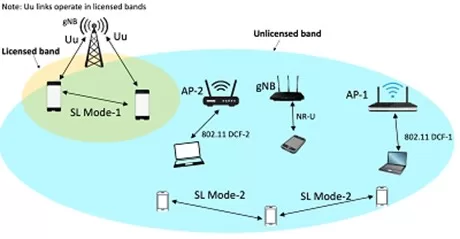Introduction
The 3GPP Release 18 set standards and specifications that aim to expand and enhance various aspects of 5G. From enabling advanced navigational capabilities to enhancing various industrial and IoT solutions, the enhancements in NR Positioning with 3GPP Release 18 involve significant improvements in how devices are located within 5G networks.
NR positioning refers to the methods and technologies used to determine the physical location of user equipment (UE) within the network.
In this article we will explore how these advancements not only cater to the growing demand for higher accuracy and lower latency in location services but also open doors to innovative applications across diverse sectors, from industrial IoT to consumer-oriented services.
New Applications and Requirements
As 5G networks evolve, they bring forth a realm of new applications demanding unprecedented accuracy and reduced latency in location services.
With Release 16, 5G began enhancing indoor positioning to a 3-meter accuracy, expanding outdoors up to 10 meters, employing high time resolution and multi-beam angle approaches. Yet, it aspired for more granular precision.
Advancing to Release 17, the focus shifted to achieving centimeter-level accuracy, curtailing delays, and ramping up overall efficiency.
Release 18 continues this trajectory, introducing Low Power High Accuracy Positioning (LPHAP) for even more refined sub-meter accuracy. It also aims to streamline power usage and reduce latency, thereby aligning with the rigorous demands for precision and speed in various sectors. This includes applications in automated vehicular systems, intricate industrial IoT networks, and consumer technologies that rely heavily on real-time data, like augmented reality gaming and navigation services. This progression is detailed in the table below.
Table 1: Evolution of 3GPP NR Positioning: Comparing Releases 16, 17, and 18 in Terms of Bandwidth, Accuracy, and Key Features
| Release | Bandwidth | Positioning Accuracy | Target Requirements | Key Features |
| Rel-16 | 100 MHz | 1–3 m | Regulatory: Horizontal ≤ 50 m, Vertical < 5 m, Latency < 30 s; Commercial: Indoor Horizontal < 3 m, Vertical < 3 m, Outdoor Horizontal < 10 m, Vertical < 3 m, Latency < 1 s | RAT-dependent techniques; PRS and SRS for positioning |
| Rel-17 | 100 MHz | 0.5 m | Commercial: Horizontal < 1 m, Vertical < 3 m, Latency < 100 ms (End-to-end), < 10 ms (Physical); IIoT: Horizontal < 0.2 m, Vertical < 1 m, Latency < 10 ms | Enhancements in signaling and measurements; On-demand DL PRS; Multipath/NLOS mitigation |
| Rel-18 | 200–800 MHz | 10 cm | Support new positioning scenarios; Improve accuracy | Sidelink positioning, RedCap UEs, LPHAP for IIoT; PRS/SRS bandwidth aggregation; NR carrier phase-based positioning; Integrity and power efficiency improvements |
For Industrial IoT (IIoT), the requirement for highly accurate location data is imperative. It plays a critical role in enabling automation and enhancing safety systems. The precision of location data in such environments not only facilitates efficient machine-to-machine communication but also ensures the safety of automated processes, a vital aspect in industries such as manufacturing, logistics, and healthcare.
The consumer sector, particularly applications like augmented reality (AR) games and advanced navigation services, is another domain where the enhanced capabilities of NR positioning are pivotal. These applications are not just content with pinpoint accuracy; they also demand rapid response times to provide seamless and immersive experiences. The accuracy and latency improvements in 5G NR positioning are essential in delivering the level of real-time interactivity that these applications require.
However, meeting these advanced positioning requirements poses significant challenges for network infrastructure and device capabilities. It necessitates a robust and versatile network that can support high data rates, low latency, and widespread coverage. Furthermore, device capabilities must also evolve to leverage these network improvements. This includes enhancements in hardware, such as more sensitive and accurate sensors, and software algorithms capable of processing complex positioning data efficiently.
The evolution of these technologies underlines the necessity for continuous innovation within the 5G ecosystem.
Advancements in NR Positioning Techniques
With 3GPP Release 18, a significant advancement in NR positioning techniques has been realized, particularly with the introduction of carrier phase measurements and PRS/SRS bandwidth aggregation.
Carrier phase measurements represent a breakthrough in positioning accuracy. Unlike traditional methods that rely on signal strength or time of arrival, this technique focuses on the actual phase of the radio wave. This allows for a much finer granularity in determining the position, significantly reducing the margin of error. This level of precision is particularly beneficial in applications where even slight inaccuracies can lead to substantial consequences, such as in autonomous vehicles and drone navigation.
PRS/SRS bandwidth aggregation is another key enhancement. By utilizing a wider range of bandwidth, this approach allows for more detailed and accurate positioning. It’s especially effective in urban environments, where signals can be reflected and distorted by buildings and other structures. Aggregating signals across a broader spectrum mitigates these issues, providing more reliable and consistent positioning data.
These advancements in NR positioning techniques mark a significant step forward in the evolution of 5G technology. They enhance the capacity of networks to deliver precise and reliable location services, a critical component in an increasingly connected world. As we continue to push the boundaries of what’s possible with 5G, these innovations lay the groundwork for a new era of location-based services and applications.
Integrity Measures for Positioning Data
In 3GPP Release 18, a range of robust measures has been introduced to ensure the integrity of NR positioning data, crucial for the reliability of 5G networks. These measures include advanced error detection algorithms and correction protocols, ensuring the transmitted and received location information is both accurate and reliable. For instance, enhanced signal processing techniques are used to filter out noise and interference, improving the precision of positioning data. Additionally, redundant data verification methods are implemented to cross-check and validate the location information, thus minimizing the risk of errors. These integrity measures are pivotal in applications where precise positioning is crucial, such as in autonomous systems and emergency response operations, bolstering the trustworthiness and dependability of 5G NR positioning.
Sidelink Positioning in IoT and RedCap UEs
The integration of positioning technology in IoT and RedCap UEs is a pivotal aspect of 3GPP Release 18.
Known as Low Power High Accuracy Positioning (LPHAP), it is engineered to deliver high precision location data while maintaining low power consumption.
These features are beneficial in various other scenarios as well, including extending coverage to planned cellular networks, facilitating Vehicle-to-Everything (V2X) connectivity, supporting augmented/virtual reality (AR/VR) devices, and providing network assistance for intra-body sensors.
The implementation of LPHAP involves sophisticated algorithms that optimize power usage without compromising the accuracy of positioning data.
For RedCap UEs, which are designed as a cost-effective and less complex alternative to fully-fledged 5G devices, the improvements in positioning technology are particularly crucial. These devices now have access to enhanced positioning capabilities, previously limited to more advanced equipment. This is achieved through optimized signal processing techniques and tailored protocols that allow RedCap devices to efficiently process positioning information, despite their reduced computational power.
The advancements in NR positioning for IoT and RedCap UEs in Release 18 thus represent a significant stride in making 5G technology more inclusive and versatile. This development not only broadens the reach of 5G applications but also ensures that a wider range of devices can leverage the benefits of precise and efficient positioning, enabling a more connected and efficient ecosystem.
These developments include operating in unlicensed bands and at higher frequencies with advanced beam management and carrier aggregation for multiple frequency channels. Techniques for UE-to-UE and network relaying are being refined, along with improved NR positioning for varied coverage scenarios.

Figure 1: Example of sidelink communication in unlicensed bands with IEEE 802.11 and NR-U systems
Figure 1 illustrates the coexistence of Sidelink communication in unlicensed bands with IEEE 802.11 and NR-U systems, using designated channel access mechanisms to ensure fair usage and autonomous resource allocation between directly connected devices and those linked via a gNB in licensed bands.
Conclusion
3GPP Release 18 is a transformative step in the 5G landscape, enhancing NR positioning capabilities to meet the sophisticated demands of various industries. It introduces technical innovations like LPHAP for IoT, advanced Sidelink communications, and improved integrity measures, all aimed at achieving high precision and efficiency in positioning.
These advancements are critical for enabling a diverse array of applications, from AR/VR to V2X, and ensure that even devices with reduced capabilities can benefit from 5G’s power.
Release 18 exemplifies the ongoing commitment to evolving 5G technologies, promising to unlock new possibilities and drive further connectivity in an increasingly digital world.
References
- 3GPP TR 23.700-86 V18.0.0, “Study on architecture enhancement to support ranging based services and Sidelink positioning”, 2023.
- Vijitha Weerackody, Kent Benson, and Sumit Roy, “Who Needs Base Stations When We Have Sidelinks?” IEEE CTN, 2023
- CMCC, CATT, “Revised WID: NR Sidelink relay enhancements,” RP-223050. 3GPP TSG RAN, 2022

